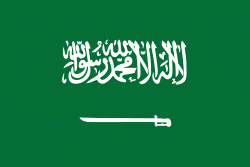Ha'il Province (Ha'il Region)
The province is popular for hosting the geographically and historically important twin mountain ranges of 'Aja and Salma, which are now areas protected by the Saudi Wildlife Authority. In addition, multiple rock art sites can be found in the province, two sites of which have been added to the UNESCO World Cultural Heritage Site List; Jabal Umm Sinman near Jubbah and Jabal al-Manjur. Multiple old forts and castles can be found in the region, especially in and around the capital, Ha'il. Another important site in the province are the sandstone formations, such as the Nafud al-Kabir formation.
The area is known to have been inhabited since at least the Paleolithic period, with several archaeological sites dating back to 10000 BC to 7500 BC. Several sites with archaeological rock art and other artifacts have been found in the province. The province is inhabited by members of the Shammar tribe, who ruled the area and other areas surrounding the province from 1791 to 1922 as the Emirate of Jabal Shammar; when King Abdulaziz conquered the region.
The province is divided into 8 governorates, and more than two-thirds of the population of the city lives in the capital city of Ha'il. The incumbent Provincial Governor is 'Abdulaziz ibn Sa'ad al-Sa'ud. It is bordered, clockwise from the north, by the Northern Borders Province, Eastern Province, Qassim Province, Madinah Province, Tabuk Province and Al Jawf Province.
Map - Ha'il Province (Ha'il Region)
Map
Country - Saudi_Arabia
 |
 |
| Flag of Saudi Arabia | |
Pre-Islamic Arabia, the territory that constitutes modern-day Saudi Arabia, was the site of several ancient cultures and civilizations; the prehistory of Saudi Arabia shows some of the earliest traces of human activity in the world. The world's second-largest religion, Islam, emerged in what is now Saudi Arabia. In the early 7th century, the Islamic prophet Muhammad united the population of Arabian Peninsula and created a single Islamic religious polity. Following his death in 632, his followers rapidly expanded the territory under Muslim rule beyond Arabia, conquering huge and unprecedented swathes of territory (from the Iberian Peninsula in the west to parts of Central and South Asia in the east) in a matter of decades. Arab dynasties originating from modern-day Saudi Arabia founded the Rashidun (632–661), Umayyad (661–750), Abbasid (750–1517), and Fatimid (909–1171) caliphates, as well as numerous other dynasties in Asia, Africa, and Europe.
Currency / Language
| ISO | Currency | Symbol | Significant figures |
|---|---|---|---|
| SAR | Saudi riyal | رس | 2 |
| ISO | Language |
|---|---|
| AR | Arabic language |
















